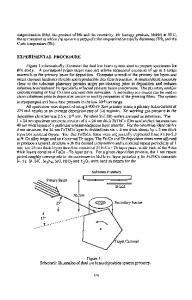Individual Layer Thickness of Sol-Gel-Derived BST Thin Films Directs Film Properties
- PDF / 143,543 Bytes
- 2 Pages / 612 x 792 pts (letter) Page_size
- 102 Downloads / 399 Views
RESEARCH/RESEARCHERS
High Electron Mobilities Achieved with an Organic Field-Effect Transistor Material In the December 4 issue of Applied Physics Letters, researchers J.H. Schön, Ch. Kloc, and B. Batlogg of Bell Laboratories report room-temperature electron mobilities as high as 5.5 cm2/Vs for an organic field-effect transistor (OFET) based on single crystalline perylene. Perylene, also called peri-dinaphthalene, has a formula of C20H12; the structure shows four 6-carbon rings surrounding, and sharing a side with, a central cyclohexane ring. This promising material shows both n- and pchannel activities, with the electron mobility clearly exceeding the hole mobility across the 50–300 K temperature range studied. In previous investigations, OFET materials consistently showed hole mobilities that were higher than electron mobilities. Single crystals of perylene approximately 1-cm2 in area and a few micrometers thick were grown from the vapor phase in a stream of flowing hydrogen. Gold source and drain contacts were thermally deposited on the perylene layer, and a dielectric layer of Al2O3 was sputtered over the surface. A gold gate electrode was evaporated on top of the structure. Structures fabricated included channel lengths from 25 to 50 µm with channel widths from 500 to 1,500 µm. Standard FET equations yielded electron mobilities of 5.5 cm2/Vs and hole mobilities of 0.4 cm2/Vs, in good accordance with time-of-flight values reported for perylene single crystals. The investigators believe the 5.5 cm2/Vs value to be the highest room-temperature mobility reported to date for an OFET in either polarity mode. The temperature-dependence of the
4
mobility for electrons followed a power law across the whole 50–300 K temperature range, with mobility increasing with decreasing temperature. The hole mobility demonstrated similar behavior down to 60 K, at which point the mobility leveled off. The researchers attributed this phenomenon to defects, disordering, or trapping processes. TIM PALUCKA
Individual Layer Thickness of SolGel-Derived BST Thin Films Directs Film Properties A team of researchers from the Shanghai Institute of Technical Physics (affiliated with the Chinese Academy of Sciences) and Shandong University has shown that the structure, ferroelectricity, and dielectric properties of sol-gelderived Ba0.8Sr0.2TiO3 (BST) thin films strongly depend on the individual layer thickness. In the October issue of the Journal of the American Ceramics Society, the researchers report that the films prepared with an individual layer thickness of 60 nm showed small equiaxed grains with a cubic structure, no ferroelectricity, and temperature-independent dielectric behavior. In contrast, films prepared with a layer thickness of 8 nm consisted of columnar grains with a tetragonal crystal structure and showed good ferroelectricity as well as two peaks in the dielectric constant-temperature curve. According to the researchers, the individual layer thickness for layer-by-layer homoepitaxy growth of BST films should be
Data Loading...










